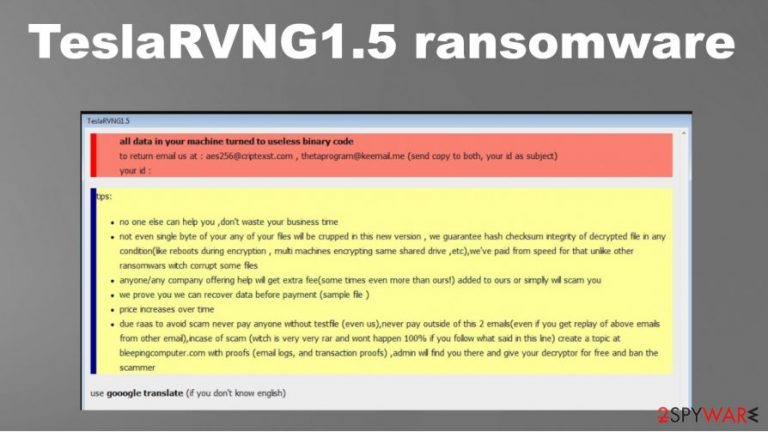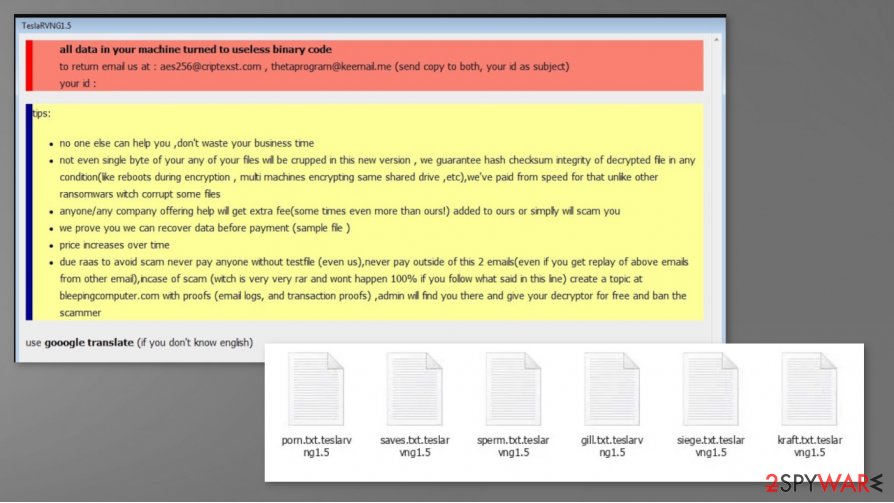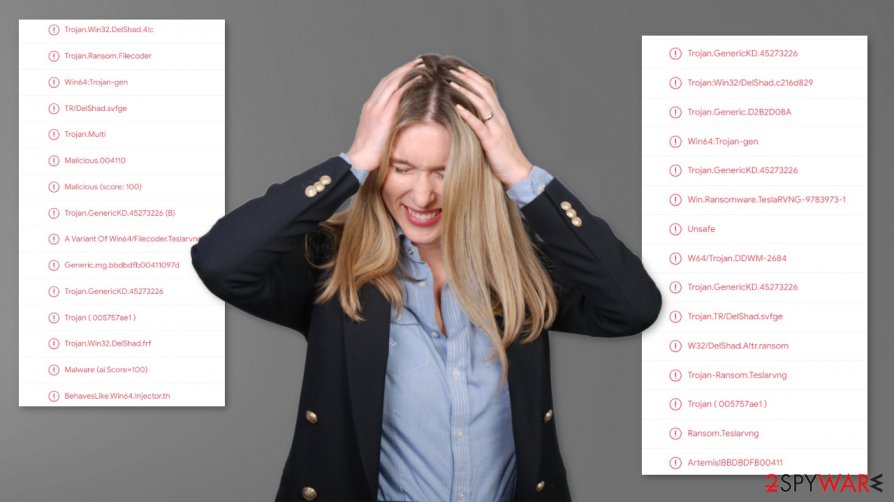TeslaRVNG1.5 ransomware (Virus Removal Guide) - Recovery Instructions Included
TeslaRVNG1.5 virus Removal Guide
What is TeslaRVNG1.5 ransomware?
TeslaRVNG1.5 ransomware – a new file-locking-type computer infection from the Ouroboros family

TeslaRVNG1.5 ransomware is a malicious computer virus developed to extort money from its victims by encrypting their files and demanding a ransom to unlock them. This cryptovirus derives from a relatively small ransomware family of Ouroboros, with members like Odveta virus, Zeropadypt NextGen virus, and others.
During the encryption, TeslaRVNG1.5 ransomware virus renames all data in a complex manner by prepending id[unique user ID].[tesla369@cock.li] and appending .teslarvng1.5 extension to all original filenames. In other words, if you had a file named a.pdf, it would now appear as id[unique user ID].[tesla369@cock.li].a.pdf.teslarvng1.5. Keep in mind that when files get locked, their contents aren't corrupted.
Following the file lockage, the file-locking parasite generates a ransom note, titled teslarvng1.5.hta, and leaves it on the desktop. When the file is opened, it appears as a pop-up window. With this note, cybercriminals want to pursue their victims to contact them by any of the two given emails – tesla369@cock.li, teslacrypt369@cyberfear.com.
Some of the previous versions from this lineage have already been decoded, so it's not the end of the world if you got your machine infected. We're happy you're here, as we strive to help our readers who are in a bit of a pickle. This article provides detailed instructions on how to get rid of TeslaRVNG1.5 virus both manually and automatically.
| name | TeslaRVNG1.5 ransomware |
|---|---|
| Type | Ransomware, file-locking virus |
| Family | Ouroboros |
| ransom note | teslarvng1.5.hta |
| appended file extension | Encrypted files receive id[unique user ID].[tesla369@cock.li].(original filename).teslarvng1.5 extension |
| Criminal contact info | tesla369@cock.li, teslacrypt369@cyberfear.com |
| Distribution | RDP attacks, scam emails, file-sharing platforms |
| virus removal | Trustworthy anti-malware software must be used to eliminate such cyber infections and prevent them from gaining control of the device |
| System Repair | During the infection, system files get altered, which may lead to unstable system performance. Scan your computer with the FortectIntego system repair tool to fix any system issues |
Ransom notes are created to scare and convince people that there are no other means to regain access to their files apart from paying the assailants. In many cases, that might be true, but under no circumstances do we agree with that. Actually, paying the ransom is the worse thing that an owner of an infected device could do because:
- It motivates the criminals to attack more innocent computer users
- Paid money finances their research for better infection techniques
- It finances the development of more sophisticated cyber threats
As soon as a user sees a ransom note or that their files are inaccessible, they must scan their devices with dependable anti-malware software, such as SpyHunter 5Combo Cleaner or Malwarebytes, and get rid of any suspicious files. The same should be done with this article's culprit – perform a full system scan, and remove TeslaRVNG1.5 ransomware.
There's no point in reading the ransom note, as it is pretty much the same as all notes from all other cryptoviruses. The price isn't specified, nor is the preferred payment method (based on our research, it will most likely be Bitcoins). The whole note from the threat actors behind TeslaRVNG1.5 ransomware states:
all data in your machine turned to useless binary code
to return email us at : tesla369@cock.li , teslacrypt369@cyberfear.com (send copy to both, your id as subject)
your id : –
tips:
no one else can help you ,don't waste your business time
anyone/any company offering help will get extra fee(some times even more than ours!) added to ours or simplly will scam you
we prove you we can recover data before payment (sample file )
price increases over time
due raas to avoid scam never pay anyone without testfile (even us),never pay outside of this 2 emails(even if you get replay of above emails from other email),incase of scam (witch wont happen 100% if you follow what said in this line) create a toptic at bleepingcomputer.com with proofs (email logs, and transaction proofs) ,admin will find you there and give your decryptor for free and ban the scammer
We're going to reiterate one point – PLEASE DON'T CONTACT THE CRIMINALS OR PAY THE RANSOM. The only way to stop TeslaRVNG1.5 ransomware and other crypto-malware from spreading is by stoping the criminals from getting richer. If no one would pay the ransom, the criminals would be broke and wouldn't have the finances to develop new malware.

If you didn't have anti-malware software or the old one failed to stop the infection, get a trustworthy one, and eliminate the infection. In some cases, cryptoviruses can block this type of software from opening. Then you'll have to do a manual TeslaRVNG1.5 ransomware removal.
Please don't be scared, it's not rocket science. Just follow our step-by-step instructions at the end of this article, and you'll be done in five minutes. Once that's done, we highly advise to repair all corrupted system files with a powerful system tune-up tool like the FortectIntego.
Avoiding the most popular ransomware delivery techniques
There are various malware types,[1] such as Trojans, worms, keyloggers, etc., and its payload files are delivered using different techniques. Our cybersecurity experts report that the two most popular ways cybercriminals are spreading ransomware are through spam emails and file-sharing platforms.
Spam emails are created to spread various malware, and ransomware is one of them. Usually, the payload files are either in an email attachment or in a hyperlink that would lead to a malicious website. Please don't open any emails or their contents that urge you to do something, like visit a certain site immediately because of some security issues, or download the attachment with important new details. Criminals use these techniques to trick people.
File-sharing platforms offer various copyrighted movies or pirated software for free. Cybercriminals exploit people's weakness for free stuff by camouflaging their creations as the most anticipated cracked games, free installers of expensive software, and alike. Refrain from using these sites altogether because any offered content might have a very unpleasant surprise hidden within.

Tutorial for TeslaRVNG1.5 ransomware virus removal and system tune-up
To stay safe on the internet, people should acquire reliable anti-malware software such as SpyHunter 5Combo Cleaner or Malwarebytes because cyber infections are hiding everywhere these days. Professional AV tool will not only remove TeslaRVNG1.5 ransomware but prevent all kinds of malware and crapware from infecting devices if you keep them running from time to time.
The importance of a trustworthy anti-malware tool can be seen in a suspicious file analysis portal VirusTotal, which research shows[2] that 34 out of 71 anti-virus engines caught the TeslaRVNG1.5 ransomware virus, thus preventing infection. Here's a couple of detection name variations:
- Ransom.Teslarvng
- Program:Win32/Vigram.A
- Trojan.GenericKD.45273226 (B)
- Win64:Trojan-gen
- Trojan.Gen.MBT
If anti-malware tools are blocked by the cryptovirus, meaning they can't be opened, then reboot your computer and start it in Safe Mode with Networking. Then TeslaRVNG1.5 ransomware removal shouldn't be impeded. If you don't know how to launch that mode, refer to our free guide below.
Once the machine is virus-free, the next step is taking care of the system files and settings. To do that automatically, experts [3] suggest downloading and running FortectIntego – a powerful system repair tool. This app will find all system irregularities and fix them with a push of a button so you could enjoy your device anew.
Getting rid of TeslaRVNG1.5 virus. Follow these steps
Manual removal using Safe Mode
Booting up the computer in Safe Mode with Networking and removing the infection
Important! →
Manual removal guide might be too complicated for regular computer users. It requires advanced IT knowledge to be performed correctly (if vital system files are removed or damaged, it might result in full Windows compromise), and it also might take hours to complete. Therefore, we highly advise using the automatic method provided above instead.
Step 1. Access Safe Mode with Networking
Manual malware removal should be best performed in the Safe Mode environment.
Windows 7 / Vista / XP
- Click Start > Shutdown > Restart > OK.
- When your computer becomes active, start pressing F8 button (if that does not work, try F2, F12, Del, etc. – it all depends on your motherboard model) multiple times until you see the Advanced Boot Options window.
- Select Safe Mode with Networking from the list.

Windows 10 / Windows 8
- Right-click on Start button and select Settings.

- Scroll down to pick Update & Security.

- On the left side of the window, pick Recovery.
- Now scroll down to find Advanced Startup section.
- Click Restart now.

- Select Troubleshoot.

- Go to Advanced options.

- Select Startup Settings.

- Press Restart.
- Now press 5 or click 5) Enable Safe Mode with Networking.

Step 2. Shut down suspicious processes
Windows Task Manager is a useful tool that shows all the processes running in the background. If malware is running a process, you need to shut it down:
- Press Ctrl + Shift + Esc on your keyboard to open Windows Task Manager.
- Click on More details.

- Scroll down to Background processes section, and look for anything suspicious.
- Right-click and select Open file location.

- Go back to the process, right-click and pick End Task.

- Delete the contents of the malicious folder.
Step 3. Check program Startup
- Press Ctrl + Shift + Esc on your keyboard to open Windows Task Manager.
- Go to Startup tab.
- Right-click on the suspicious program and pick Disable.

Step 4. Delete virus files
Malware-related files can be found in various places within your computer. Here are instructions that could help you find them:
- Type in Disk Cleanup in Windows search and press Enter.

- Select the drive you want to clean (C: is your main drive by default and is likely to be the one that has malicious files in).
- Scroll through the Files to delete list and select the following:
Temporary Internet Files
Downloads
Recycle Bin
Temporary files - Pick Clean up system files.

- You can also look for other malicious files hidden in the following folders (type these entries in Windows Search and press Enter):
%AppData%
%LocalAppData%
%ProgramData%
%WinDir%
After you are finished, reboot the PC in normal mode.
Remove TeslaRVNG1.5 using System Restore
Using System Restore for virus elimination
-
Step 1: Reboot your computer to Safe Mode with Command Prompt
Windows 7 / Vista / XP- Click Start → Shutdown → Restart → OK.
- When your computer becomes active, start pressing F8 multiple times until you see the Advanced Boot Options window.
-
Select Command Prompt from the list

Windows 10 / Windows 8- Press the Power button at the Windows login screen. Now press and hold Shift, which is on your keyboard, and click Restart..
- Now select Troubleshoot → Advanced options → Startup Settings and finally press Restart.
-
Once your computer becomes active, select Enable Safe Mode with Command Prompt in Startup Settings window.

-
Step 2: Restore your system files and settings
-
Once the Command Prompt window shows up, enter cd restore and click Enter.

-
Now type rstrui.exe and press Enter again..

-
When a new window shows up, click Next and select your restore point that is prior the infiltration of TeslaRVNG1.5. After doing that, click Next.


-
Now click Yes to start system restore.

-
Once the Command Prompt window shows up, enter cd restore and click Enter.
Bonus: Recover your data
Guide which is presented above is supposed to help you remove TeslaRVNG1.5 from your computer. To recover your encrypted files, we recommend using a detailed guide prepared by 2-spyware.com security experts.If your files are encrypted by TeslaRVNG1.5, you can use several methods to restore them:
Data Recovery Pro could help to restore files
This third-party app might help to restore .teslarvng1.5 extension files.
- Download Data Recovery Pro;
- Follow the steps of Data Recovery Setup and install the program on your computer;
- Launch it and scan your computer for files encrypted by TeslaRVNG1.5 ransomware;
- Restore them.
Recover individual files with Windows Previous Version feature
Try this feature to recover .teslarvng1.5 extension files. There's no guarantee that that will work, but you could try it anyways.
- Find an encrypted file you need to restore and right-click on it;
- Select “Properties” and go to “Previous versions” tab;
- Here, check each of available copies of the file in “Folder versions”. You should select the version you want to recover and click “Restore”.
Restoring data with Shadow Explorer
This application restores files from Shadow Volume Copies. If the cyber infection didn't delete them then you might be in luck.
- Download Shadow Explorer (http://shadowexplorer.com/);
- Follow a Shadow Explorer Setup Wizard and install this application on your computer;
- Launch the program and go through the drop down menu on the top left corner to select the disk of your encrypted data. Check what folders are there;
- Right-click on the folder you want to restore and select “Export”. You can also select where you want it to be stored.
No decryption tool is currently available
Finally, you should always think about the protection of crypto-ransomwares. In order to protect your computer from TeslaRVNG1.5 and other ransomwares, use a reputable anti-spyware, such as FortectIntego, SpyHunter 5Combo Cleaner or Malwarebytes
How to prevent from getting ransomware
Choose a proper web browser and improve your safety with a VPN tool
Online spying has got momentum in recent years and people are getting more and more interested in how to protect their privacy online. One of the basic means to add a layer of security – choose the most private and secure web browser. Although web browsers can't grant full privacy protection and security, some of them are much better at sandboxing, HTTPS upgrading, active content blocking, tracking blocking, phishing protection, and similar privacy-oriented features. However, if you want true anonymity, we suggest you employ a powerful Private Internet Access VPN – it can encrypt all the traffic that comes and goes out of your computer, preventing tracking completely.
Lost your files? Use data recovery software
While some files located on any computer are replaceable or useless, others can be extremely valuable. Family photos, work documents, school projects – these are types of files that we don't want to lose. Unfortunately, there are many ways how unexpected data loss can occur: power cuts, Blue Screen of Death errors, hardware failures, crypto-malware attack, or even accidental deletion.
To ensure that all the files remain intact, you should prepare regular data backups. You can choose cloud-based or physical copies you could restore from later in case of a disaster. If your backups were lost as well or you never bothered to prepare any, Data Recovery Pro can be your only hope to retrieve your invaluable files.
- ^ Robert Izquierdo. 10 Types of Malware and How to Spot Them. Fool. Software reviews and recommendations.
- ^ VirusTotal. Virustotal. Suspicious file analysis.
- ^ Utanvirus. Utanvirus. Spyware and security news.







